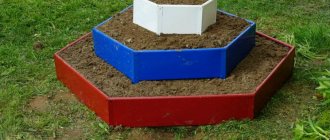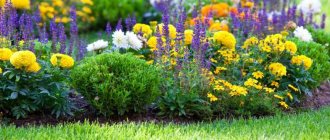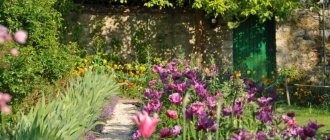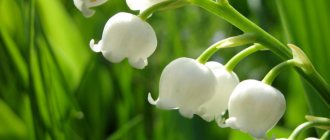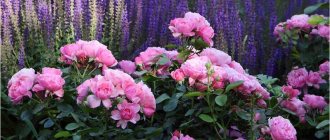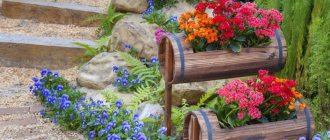Floral arrangements that delight the eye with gorgeous blooms throughout the season are a dream that can easily be realized in your garden by choosing the right plants. A flowerbed of continuous flowering is an excellent option for creating a floral masterpiece that does not freeze for a single moment, from the contemplation of which you receive aesthetic pleasure at any time of the year. The secret to creating such a flower bed is quite simple: to achieve endless beauty, it is enough to select plants with different flowering periods and complement the composition with abundantly flowering annuals, as well as specimens with decorative foliage.
What is a flowerbed of continuous flowering?
- A flower bed of continuous flowering is usually called a flower garden for which plants are selected according to several parameters at once: height, color, leaf shape, growth rate, etc.
- In this case, the main indicator for selection is the flowering time of the plant: it is important that flowering specimens are constantly present in the flowerbed. Those that have already bloomed, as well as those that are still in the growth period, act as a background component.
- A flowerbed of continuous flowering can also rightfully be defined as a mixborder . The word “mix” itself suggests that mixing is taking place: colors and shades, tall and short, perennials and annuals. And if you use evergreen and coniferous plantings in the design of such a flower bed, it will please the eye even in winter.
Constant flowering
Option 3. Flower bed along a fence or wall
When decorating a flower bed along a fence or wall, you should also follow the rules for planting plants in the form of a “ladder”. Therefore, low-growing shrubs or flowers are planted in the foreground.
In the diagram presented above, Japanese spirea and ground cover roses are placed closer to the edge of the flower bed. It is no coincidence that juniper is planted between them; it serves as a kind of dividing layer between two shrubs blooming at the same time.
To give the flower garden a more solemn appearance and create a symmetry effect, tall plants with a pyramidal crown are planted along the fence. The basis of this composition is made up of paniculata hydrangea bushes, located in the center. The white summer flowering of hydrangea is supported by pale pink candle-shaped inflorescences of Douglas spirea; the symmetry is emphasized by pyramidal thujas beautifully standing on both sides of the flower garden. Delphinium sets the color in the autumn period and with its height enhances the effect of “striving upward”.
What are the basic rules for forming a flowerbed of continuous flowering?
- The first and most necessary rule is that the size of a continuous flowering bed must be large , since in order for it to be a blooming oasis for a long time, it is necessary to plant many types of flowers.
- The second rule is the predominant use of perennial specimens; they are easier to care for and bloom regardless of when they are sown and when the seedlings are planted in the flowerbed.
- The third point is the choice of unpretentious flowers . This is due to the fact that each plant has its own requirements regarding soil, frequency and abundance of watering, lighting and other factors. Having planted rather capricious plants nearby, it will be difficult to achieve comfort for each of them.
- The fourth rule is to stick to a natural style with a loose fit . It is better to plant flowers not individually, but in groups, otherwise you will end up with a motley mishmash in which it will be difficult to consider each species. An exception may be large bush specimens, for example, tree peony.
- Fifth rule: choose plants for planting in the flowerbed whose foliage does not dry out or become wilted after the color ends . This will provide a bright green background for a long time, otherwise your flowerbed will look sloppy. An excellent example are the Arabis flowers, which, having stopped blooming as early as May, can remain a variegated green and white border until the autumn days.
- And finally, the sixth rule: annually “put things in order” in a flowerbed of continuous flowering, removing specimens that have already lost their decorative effect, replacing them with new ones.
Bright bloom
Important aspects in creating
Beautiful flower beds
In order not to ruin all your work, at the stage of planning a flower garden you need to take into account several important distinctive features:
- There should be an extensive list of plant species. From the first days of spring until the coldest weather, the flower garden will have a constantly blooming appearance
- Plant more perennial varieties. These species require less attention to care and are not afraid of cold weather. For the next few years, you don’t have to worry about the design of the site, because the process of growing and blooming flowers will take place annually on its own. You just need to take care of the plants on time. They will grow very large every year
- Opt for non-capricious plantings. They will have to coexist with each other, so they should not suffer from this. Unpretentiousness to the conditions will help them not feel discomfort
- Large colored spots will add expressiveness to the overall picture. It is not advisable to plant flowers one by one, because... fragmentation of the composition, the predominance of small elements in it will only irritate the eyes. Plants that bloom at approximately the same time are best grouped together
- The dimensions of the flowerbed should correspond to the general style of the site. If the area does not allow you to make a large flower bed, then the effect of constant flowering can be achieved by planting several small seasonal flower beds. The same option is suitable for areas where there is a large predominance of straight lines. The flower garden will not look very beautiful if you try to squeeze it into a strict framework
Landscaping your site with your own hands – (130+ Photos of ideas & Videos) + Reviews
How to create a flower bed with perennial flowers that bloom continuously?
- It is necessary to carry out work on planting perennial plants, creating a flowerbed of continuous flowering, in the fall - this way the plants will take root and bloom within a few months, with the onset of spring. At the same time, bulbous plants are also planted that overwinter in the ground, for example, daffodils with crocuses, tulips with galanthus, hyacinths and scylla.
- If you are already growing perennials, then you have decided how adaptable they are to the conditions and the sequence of their flowering. This way you can form the basis of an ever-blooming flowerbed, and if your flower beds have moments when flowering is not observed, purchase flowers that bloom during these periods so that they fill these “gaps”.
- identical specimens with early and late flowering periods in such an ever-blooming flowerbed , especially if you like this or that flower - this way you will prolong the pleasure of admiring them. For example, from the beginning of May your eye will be pleased with dwarf varieties of irises, and at the beginning of summer - tall beauties.
- You can also supplement a continuous flowering bed with annuals that have a long flowering period: salvias, verbena, marigolds, petunias , etc. They will perform two functions at once: they will become a wonderful bright accent until the perennial plants bloom, and they will “cover” those places where the plants have been damaged by pests or an unsuccessful wintering.
For permanent beauty in the flowerbed
Option 2. The flower garden is in the shade and surrounded by paths
In the shade, it is usually necessary to plant plants that do not do well in direct sunlight or prefer moist soil. These conditions are met by shade-tolerant hosta, bergenia, geranium, thuja, irises, and horizontal juniper.
Moreover, it is necessary to arrange the plants correctly in height. Knowing that hostas, bergenias and geraniums grow up to 30-40 cm, they are planted in the foreground. Closer to the middle of the flower garden, taller plants are placed: thuja globulus, larch on a trunk, irises, daylilies, aquilegia.
It should be remembered that shade-loving plants, as a rule, delight not with flowering, but with their openwork and succulent foliage or needles. Therefore, shady flower beds are mostly monochromatic.
How to choose a color scheme for a flower bed of continuous flowering perennials?
- This is quite a difficult task, because changes in the color scheme of an ever-blooming flowerbed occur more than once during the season. In spring, when primroses bloom, shades and colors change quickly, just as the first spring flowers fade. A combination of white and blue would be appropriate here; when crocuses and snowdrops , they are replaced by daffodils and primroses, which paint the flowerbed with all the colors of the rainbow. Then comes the turn of tulips, which also have a wide variety of colors, and will be complemented by white arabis, yellow doronicum and blue-blue shades of forget-me-nots and muscari .
- The same bright palette is represented by irises , the most popular colors of which are lilac, blue, and yellow-brown. Then peonies bloom along with daylilies and delphinium. They will be perfectly shaded by perennial carnations that have a small height. The phloxes and astilbes that will replace them can be selected not only depending on the shade, but also taking into account their height and flowering time, complementing them with pink echinacea or white nevus.
- As for roses , their flowering time is from the first days of summer until the onset of autumn cold weather. Their colors and varieties are so diverse that, by selecting specimens that bloom early, you can arrange a flowerbed of continuous flowering from only roses.
- Autumn flowering is the time of chrysanthemums, dahlias, marigolds, calendula, salvia . Most often they create a yellow-red color scheme. And, of course, while waiting for the growth of perennial plants, it would not hurt to supplement the flowerbed with annuals, for example, petunias, which can delight the eye with their color throughout the summer.
Option 4. Flowerbed separating the recreation area from the vegetable garden
As a rule, such flower beds are located in a sunny place in the middle of the site. In such a composition, plants are planted whose height reaches no more than 2-3 m. This is necessary so that they do not create a large shadow.
In early spring, the flower garden is decorated with conifers: junipers, spherical and pyramidal thujas (for example, the vertical is emphasized by the pyramidal thujas Smaragd). Closer to summer, the baton is taken over by Luteus and irises, and ground cover roses, hydrangeas and alpine carnations are responsible for summer flowering.
How to choose flowers for a flower bed of continuous flowering perennials?
When selecting plants, it is important to consider several parameters:
- Flowering time;
- Coloring of specimens;
- Flower height;
- Similar growing conditions.
Lush flowering in a flowerbed
- If everything is clear enough with the first three points - select flowers for a flowerbed of continuous flowering so that some fade while others bloom at this time, plant them so that low-growing specimens are not covered by tall plants, and according to the color scheme - it all depends depending on your preferences, then the conditions of detention and compatibility should be discussed separately.
- Flowers need to be selected so that they all feel good in similar conditions. That is, they should have approximately similar requirements regarding the frequency of watering, soil composition and moisture content, as well as illumination. For example, if you plant snowdrops or hosta , which prefer shade, and verbena and poppy, which need as much sun as possible, then some specimens will be uncomfortable. Irises that require frequent watering and echinacea that does not like excessive moisture are also unlikely to get along in the same conditions. And on poor soils oregano will grow, but rhododendron will disappear.
- In addition, keep in mind that lilies of the valley , for example, due to their fast-growing root system, can grow throughout the entire flowerbed, and the bluebell is characterized by self-seeding, which can also lead to its growth in those places that you planned for completely different flowers. The sunflower depletes the soil, taking nutrients from it, which is destructive for its neighbors.
Great design
Growing conditions
Before you make a flower garden with your own hands, you need to consider:
- Climate. When selecting plants, it is necessary to choose those that will grow comfortably in the climatic zone of the site.
- Terrain. When planting plants, you can take advantage of the terrain.
- The nature and composition of the soil. Many plants need fertile soil. These include lupins and bells. Others prefer loam or sand. This is flax, sage. Asters and yarrow grow well on marshy soil. Phlox and carnations are cultivated on dry soils.
- Illumination of the area. As a rule, all flowers love sunny places. Ferns, lilies of the valley, and hosts are suitable for dark places.
- Planting density and flowering season. You should not plant flowers very closely, they will interfere with each other.
When and how to plant flowers for a flower bed of continuous flowering perennials?
- Perennials are best planted in early autumn so that they can establish, overwinter and begin flowering in the spring. The same is done with bulbous plants.
- And so that the continuous flowering bed is not empty before they begin to bloom, you can plant seedlings of annuals as early as February and when the heat becomes stable, transplant them to the flowerbed, where they will create bright spots of color. If you plant them directly in the soil in warm spring, they will begin to bloom later.
- When planting perennials, give them up to half a meter of space so they can grow. The same should be done with annuals. It doesn’t hurt to make a kind of “stock” of annual plants in a separate place: if you see that a void is forming somewhere, you can fill it with these specimens.
- It is better to start planting annuals from the central part of the flowerbed, and if you are not planting in a circle, then at the back.
Annual plants
Among the annuals, sweet peas , marigolds , snapdragons , nasturtiums , zinnias , salvias , and sweet tobacco are .
cosmos , mallow , malopa , lavatera , ursinia , and decorative beans bloom . But they will bloom throughout September.
Marigold
Marigolds, Tagetes, marigolds, caps are synonymous names of annual plants of the genus Tagetes of the Asteraceae family. They come from North America.
Marigolds are the most unpretentious flowers for a flower bed, the best plants for beginners
Their advantages are obvious:
- good germination and fast growth. It can be grown through seedlings in the second half of March - early April, as well as by direct sowing of seeds in May (dates for the middle zone);
- unpretentiousness - grows in the sun and in light shade, can tolerate heat and drought, is undemanding to soil, but prefers light, fertile ones;
- Decorative – characterized by constant, abundant flowering from June until frost, the main thing is to periodically pick off wilted inflorescences.
Yes, marigolds have been grown for a long time, but not everyone likes their specific smell, and many gardeners are already fed up with them. In this case, we suggest paying attention to the new products that appear every year.
The amazing variety “Fantastika” with its inflorescences resembles large-flowered chrysanthemums
American breeders have developed a variety of rejected marigolds , “Strawberry Blonde,” which is a “chameleon”: a whole palette of shades blooms on one plant over the course of a season – from raspberry-brown, carmine-pink to orange-golden and pale yellow.
“Strawberry blonde” grows up to 25-30 cm, the diameter of the inflorescences is 6 cm
Marigolds look good in joint plantings with other annuals. If you select compositions by color, you can get original combinations that highlight the beauty of all participants.
A harmonious duet of warm yellow-orange with delicate lilac-blue - marigolds plus ageratum
Gardeners grow three types of marigolds : erect, deflected, thin-leaved. We have combined information about them into a table:
| View | Characteristics: habit (appearance), height | Varieties and hybrids |
| Erect (African) | Strong plants forming a bush of straight stems. Medium- and tall-growing ones reach from 40 to 120 cm in height. Distinguished by large double inflorescences | Orange – “Hawaii”, “Orange”, “Orange Knight”, lemon yellow – “Burke Lemon”, “Lemon Prince”, “Lemon Giant”, yellow – “Antigua Gold”, “Yellow Stone”, “Supra F1” , white and cream - “Eskimo”, “Kilimanjaro”. Undersized : "Cupid", "Snow Storm", "Golden Age" |
| Rejected (French) | Low-growing plants, reaching 15-40 cm. Inflorescences of medium size, simple, semi-double, double | Clove-shaped (reed petals) - “Rumba”, “Monetta”, “Tango”, “Cross of Honor”; chrysanthemum-shaped (tubular petals) - “Bonita”, “Bolero”, “Carmen”; anemone-shaped (tubular flowers in the middle, ligulate along the edges) - “Tiger Eyes”, “Spray Petite”, “Mackenna’s Gold” |
| Thin-leaved (Mexican) | Low, up to 20 cm, densely leafy (small, highly indented leaves), with many small simple flowers | “Karina orange”, “Lemon gem”, “Paprika”, “Ursula golden yellow”, “Starfire” |
Levkoy
Levkoy gray or matthiola is a beautiful plant of the Brassica family. It has a straight, slightly pubescent stem, lanceolate, fleecy or smooth leaves. The flowers are large, simple or double, white, yellow, pink, purple, lilac, violet, collected in dense racemes. The culture is light-loving, prefers light, moderately fertile and moist soils. Tolerates slight cold.
Levkoy is perfect for cutting, can stand in water for up to two weeks
Among the levkoys there are shrub and dwarf forms. Almost all of them emit a pleasant aroma during the flowering period.
Levkoy long-petaled is better known as matthiola bicornuata (Night Beauty), valued for its characteristic violet aroma, intensifying in the evenings.
Multifloral bean
For vertical gardening of fences, gazebos, verandas, arches, climbing plants are used, for example, decorative beans, which belong to the Legume family. Its smooth herbaceous stems grow up to 4 m long. The leaves are dark green, imparipinnate. The flowers are medium-sized, white, red or red-white. Beans grow better in lighted areas. Its large seeds (beans) are planted in early May immediately in a permanent place. In order for the plants to produce good foliage and many flowers, you need to adhere to the correct agricultural techniques: carry out regular fertilizing, abundant watering, and mulch the soil.
Red “Duchess” with a combined color is one of the highly decorative varieties
It is better to grow annuals through seedlings - this will allow you to quickly get a flowering flower bed. The exceptions are nasturtium, eschscholzia, beans, poppy seeds, lupine, whose sensitive root system does not like replanting. They are grown by direct sowing.
Annual seedlings should be planted in a permanent location when the threat of return spring frosts has passed.
For lush, continuous flowering, it is necessary to remove faded flowers and inflorescences. Many species require pinching the tops and pruning to stimulate the formation of side shoots with new flower stalks.
How to care for a flower bed of continuous flowering perennials?
- Flowers need feeding. Since there are many types of them, it is better to use universal formulations, which are applied in small quantities 3-4 times during the warm season.
- When the flower has faded, remove it immediately, as self-seeding is possible, which will ruin your flowerbed next season. In addition, wilted flowers, like leaves, will make a flower bed of continuous flowering unsightly and untidy. At the same time, if withered leaves are practically not visible due to the flowers growing in front, you don’t have to cut them off - the appearance of the flower garden will not be affected, and the soil will receive additional organic fertilizer.
- Pay special attention to bulbous plants. They usually overwinter well in the ground without the need for digging. The exception is particularly sensitive varieties that are not adapted to frost, which are better to dig up.
- Also, at the end of flowering, when the stem dries, you can dig up those plants that have grown too much. The bulbs should be carefully separated from each other, dried and stored until the autumn, when they can be planted in open ground.
Where to get an idea
Having decided to make a beautiful flowerbed of perennials on your site, first you should draw what the flowerbed will be like in your imagination, then you can transfer the idea to paper. But if it is possible to take an idea from a magazine or the Internet, then a photo of a flower bed of perennials can serve as the basis for creation.
No need to worry if you wanted to have a flowerbed that would only be yours. You can add your own ideas to any project and get a unique result.
How to make a diagram of a flower bed of continuous flowering perennials: examples
- A previously drawn up schematic picture of a future flowerbed of continuous flowering will help you better imagine what the combination of colors will look like , how many plant specimens will be needed, and which ones exactly. You can sketch out several diagrams to clearly see the advantages of a particular option and its applicability in the conditions of the area you have allocated for planting.
- The diagram can be drawn on a large sheet of paper, divided into cells, taking a scale for each cell: depending on the total area of your flower garden, you can consider one cell as a quarter or half a meter. Now fill the cells, looking for the optimal place for the plants that you plan to plant: this way you will clearly see who is next to whom, whether the flowers replace each other in terms of flowering time, whether they are combined in height and color scheme. In such a diagram, you can also provide for the diameter that a bush planting of a particular plant will reach in 3-4 years.
- The basic rules for filling a flower bed with perennials have already been described above. By adhering to them, you can create a flowerbed according to a pattern that will give you the opportunity to admire continuous flowering, starting from March-April and ending with the days of November.
Flowerbed diagram
Example 1:
A universal composition that combines specimens that bloom at different times. They are marked with the following positions:
- snow forsythia;
- lungwort;
- delphinium;
- herbaceous sunflower;
- miscanthus chinensis;
- Phlox paniculata;
- daffodils;
- helenium;
- hellebore;
- astrantia;
- coreopsis whorled;
- hare cabbage;
- geranium;
- aquilegia;
- catnip;
- sage;
- cushion aster;
- bellflower peach;
- portable flowerpot with seasonal plants;
- geranium;
- The cuff is soft.
Result
Scheme
Example 2:
Another option for a flower bed of perennial plants, which can be laid out both in the shade and in a well-lit place. This flowerbed is designed according to the principle of a year-round combination of yellow, red and blue-blue shades:
- stock-rose (can be any shade);
- ten-petalled sunflower;
- Iceland poppy;
- St. John's wort, odorless;
- cardinal's lobelia;
- Fassin's catnip;
- Poskharsky's bell;
- catananche blue;
- Gravilat Chilean Feuerball;
- sedum Matrona;
- Heuchera blood red.
Scheme
Example 3:
This diagram shows an autumn flower garden, in which there are:
- Thuja occidentalis "Yellow Ribbon";
- Three types of Echinacea: “Mama mia”, “Marmalade” and “Tangerine Dream”;
- Spiraea japonica "Golden Carpet";
- Penisetum foxtail "Little Bunny";
- Sedum “Black Beauty” (our better known name is sedum);
- Juniper "Lime Glow";
- Pennisetum bristly "Rubrum";
- Switchgrass "Rotstrahlbusch".
Combination
Example 4:
And here is an example of a diagram of a flowerbed of continuous flowering in the spring-summer period, following all the rules for placement according to plant height:
- geranium macrorhizomatous;
- sedum;
- Siberian iris;
- golden yarrow;
- peony bush "Rubra Plena";
- switchgrass bush “Heavy Metal”;
- common mordovnik bush.
Constant flowering
Example 5:
And here is an original decorative solution: the color scheme of the planted plants creates the illusion of a flowing stream:
- bamboo leaf (you can choose ostrich as a replacement option);
- irises;
- lobelia;
- creeping tenacious;
- Poskharsky's bell;
- aubrieta hybrids;
- Brunnera macrofolia;
- awl-leaved bryozoan;
- red creeping tenacious;
- and again, bamboo or ostrich, they will “close” the composition into a single whole.
Like a stream
Varieties
A common thing is a round flowerbed in a country house. But experienced florists will name many more varieties:
- Modular. A flower garden made of repeating shapes - squares, triangles, rhombuses, circles, etc.
- Mixborders. Mixed flower beds can create different patterns.
- Curbs. Low narrow plantings of flowers, used for frames and as dividers for zoning space.
- Stone gardens. A combination of colors and natural compositions and patterns made from natural stones.
- Alpine slides. Planting flowers in an area with a complex landscape in the form of a hill or hill.
- Monochrome. Planting plants that are similar in one of the characteristics: color, size, shape, etc.
Also distinguished:
- Regular and irregular flower beds - with repeated or random planting of flowers.
- Creeping and raised. With densely planted plants forming a carpet, or rising above the surface from 20 cm to one meter.
- Flowerbeds are paintings and panels that recreate an inscription, coat of arms or other image using flowers of different colors.
- Multidimensional and tiered from plants of different heights.
Flowerbed of continuous flowering perennials: tips
- To select plants that will feel comfortable in the climatic conditions of your region, pay attention to what flowers, shrubs, and herbs are planted in flower beds in parks and squares in your locality. This selection was made by professional landscapers, taking into account the requirements of the plants.
- If you like the color scheme, you can duplicate it. For example, you planted hellebore, whose snow-white flowers look great next to blue crocuses. Feel free to plant anemones and muscari nearby, which will bloom later, while maintaining the combination of white and blue.
- Plants with variegated leaves will look beautiful either in a group or as a border. The same unpretentious coleus will save you from worries about care and will delight you with an elegant look all season long.
- The continuity of flowering of your flower bed can be ensured even in winter. To do this, you can supplement the flower garden with coniferous specimens, which will make the area green and elegant even in the winter months.
Useful articles on the site:
- Perennial dahlia flowers - planting tubers, growing
- Do-it-yourself flower beds and flower beds using improvised materials
- How to properly feed house plants
- The best perennial flowers for your garden
- Blue flowers for the garden
Recommendations
Experienced gardeners willingly share with beginners the secrets they have acquired in their work:
- Low-growing crops are always placed along the edges of flower beds.
- The greatest aesthetic effect is achieved by the combination of bright buds on tall plants and faded buds on short ones.
- Plants with a short growing season in the flower bed should be planted near lush and long-lived bushes to prevent voids from forming.
- Too many different crops within one flowerbed will create a feeling of chaos.
- Low-growing plants look impressive in large groups.
- It is advisable to include bushes with colored leaves in the flowerbed.
- A good effect is created by playing on contrasts of color, shape and texture.
- The composition must contain at least 2 plants of the same species.
- There are always accent and background plants in the flowerbed.
For amateur gardeners who want to create their own composition of perennials, we have developed indicative planting schemes. For example, based on the proposed mixborder option, you can select crops of the appropriate height. It is very important to take into account the compatibility of colors and the flowering period.
Based on the indicative mixborder diagram, a novice gardener can create his own unique creation in the garden


